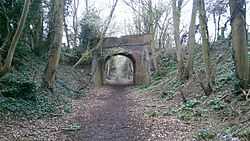Bury and Thetford (Swaffham Branch)
| Bury and Thetford (Swaffham Branch) | |
|---|---|
 Cutting near Swaffham | |
| Locale | England |
| Dates of operation | 1869–1964 (passengers) |
| Successor | Great Eastern Railway |
| Track gauge | 1,435 mm (4 ft 8 1⁄2 in) |
| Length | 18.75 miles (30.18 km) |
The Bury and Thetford (Swaffham Branch), also known as the Crab and Winkle Line,[1] was formed of the Watton and Swaffham Railway, founded in 1866 as an independent venture by the Thetford and Watton Railway Company. Freight services commenced in January 1869, with passenger services in October 1869. The line ran from Thetford, via Watton to a junction with the Lynn and Dereham Railway at Swaffham was completed in 1875.[2] The extension to Swaffham cost £72,000,[3]
On 21 July 1879 the line was leased to the Great Eastern Railway for 999 years, commencing 1 March 1880. It was vested into the GER in 1897, becoming part of the London and North Eastern Railway on 1 January 1923.[4]
The line closed to passengers in 1964 and to freight in 1965.
List of stations
Crab and Winkle Line | ||||||||||||||||||||||||||||||||||||||||||||||||||||||||||||||||||||||||||||||||||||||||||||||||||||||||||||||||||||||||||||||||||||||||||||||||||||||||||||||||||||
|---|---|---|---|---|---|---|---|---|---|---|---|---|---|---|---|---|---|---|---|---|---|---|---|---|---|---|---|---|---|---|---|---|---|---|---|---|---|---|---|---|---|---|---|---|---|---|---|---|---|---|---|---|---|---|---|---|---|---|---|---|---|---|---|---|---|---|---|---|---|---|---|---|---|---|---|---|---|---|---|---|---|---|---|---|---|---|---|---|---|---|---|---|---|---|---|---|---|---|---|---|---|---|---|---|---|---|---|---|---|---|---|---|---|---|---|---|---|---|---|---|---|---|---|---|---|---|---|---|---|---|---|---|---|---|---|---|---|---|---|---|---|---|---|---|---|---|---|---|---|---|---|---|---|---|---|---|---|---|---|---|---|---|---|---|
Legend
| ||||||||||||||||||||||||||||||||||||||||||||||||||||||||||||||||||||||||||||||||||||||||||||||||||||||||||||||||||||||||||||||||||||||||||||||||||||||||||||||||||||
- Swaffham - line and station closed.
- Holme Hale - line and station closed.
- Watton - line and station closed.
- Stow Bedon - line and station closed.
- Wretham and Hockham - line and station closed.
- Roudham Junction railway station - line open, station closed.
- Thetford - line and station open.
The route today
The line was lifted after closure. The route either side of Stow Bedon station has been removed, and the station site levelled. Watton station has also been demolished and the site redeveloped, although a level crossing gate survived on Church Road as late as 1983. The line from the junction with the Dereham line at Swaffham remains unobstructed, although with some bridges removed. Holme Hale station remains, complete with signal box and signal post - although heavily extended.[5]
Loch Neaton
One of the ballast quarries created during the construction of the railway through Watton was converted into a leisure park and bathing lake known as Loch Neaton. The area was named "Loch Neaton" in honour of the Scottish navvies who built the line, with Neaton being the local hamlet. The park remains today, bordered on one side by the abandoned railway embankment.[6]
References
- ↑ Holland, J. (2013). Dr Beeching's Axe: 50 Years on : Illustrated Memories of Britain's Lost Railways. DAVID & CHARLES. p. 68. ISBN 9781446302675. Retrieved 2015-04-03.
- ↑ "Pastscape - Detailed Result: WATTON AND SWAFFHAM RAILWAY". pastscape.org. Retrieved 2015-04-03.
- ↑ "History of Watton, Norfolk: The railway in Watton". historyofwatton.org.uk. Retrieved 2015-04-03.
- ↑ "Watton and Swaffham Railway Company | The National Archives". discovery.nationalarchives.gov.uk. Retrieved 2015-04-03.
- ↑ Norfolk Heritage Explorer: Route of Thetford, Watton and Swaffham Railway (later Great Eastern)
- ↑ Loch Neaton Watton